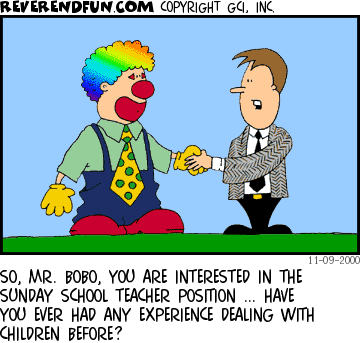
Welcome to a continuing series of tips on working with large groups of children. I hope that you will find these tips useful and be able to implement them in your dealings with large groups of kids. If you do, please leave a comment and let us know. For a complete list of posts in this series, please see the index page. So, without further introduction, here is today’s installment.
Many people think of reading stories to kids as something you do in the nursery or preschool classes. They reject it as an effective means for teaching elementary aged kids. The fact of the matter is that most kids like stories, and they like to be read to. I wouldn’t want to read them a book every weekend, but it is an effective means to break up your lessons a little bit by mixing in a week every now and then where you pull up a chair or sit on the floor and just read them a story.
There are some great books out there that I turn to from time to time for use in children’s ministry. One of my favorites is The Jesus Storybook Bible which made #2 in my list of the Top Ten Christian Books for Kids. Combining great storytelling with compelling images, this book is perfect for captivating kids and will be a great resource for your children’s minsitry. The biggest problem I have when I use it is that I find the kids crowding in trying to take in every picture and every word. I read it to my kids at home (ranging from age 2 to almost 9), and they all love it. Of course, there are also other great kids’ storybook bibles out there that you can read from.
Of course, the classic book that you should read from every week is the Bible. Frankly, this one should be a bit of a “no brainer.” Our lessons should be taken directly from God’s Word, so why not read the verses you are teaching from to the kids you are teaching? Don’t just tell them what’s in the book, read it to them so they can see it for themselves. Reading from the Bible, in addition to whatever else you do in your lesson, should build excitement about God’s Word in their hearts.
If you do choose to read, it is important that you read well. Simply reading to your kids in a monotone voice without ever looking up from the book will not inject excitement into your room. As a storyteller, it is your job to make the story come alive. Let your inner thespian shine through. I am far from dramatic, but when I read a story I use voice inflection, different voices, and different tones of voice and different reading speeds to help make the story come alive. Oftentimes, I will move around the room as I read the story to assume the parts of different characters.
Earlier in this series we discussed why you should never read your entire lesson to the kids, but you should never be afraid to read them a story!
Return to the Tips for Large Group Teaching in Children’s Ministry index page.

